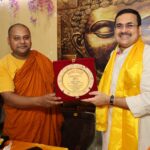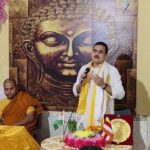India’s civilisational message and approach to civilisations of Central Asia has been one of true partnership, respect for and enrichment of diversities and the perpetuation of essential civilisational identities. Modi’s Central Asia focus is an occasion to cement such a relationship
Central Asia, which was always central to civilisational India — central to the spread of her cultural and spiritual ideals and expressions, is again at the centre with the Prime Minister Narendra Modi undertaking a tour of the countries in the region. Such a focussed and multi-dimensional visit is a reiteration of his vision of evolving and re-shaping India’s external outreach based on the pillars of samvaad, sanskriti and sabhyata (dialogue, culture, and civilisation).
Addressing indologists and a section of the intelligentsia in Tashkent — perhaps the first of its kind by an Indian Prime Minister — Mr Modi emphasised the importance of the cultural and civilisational outreach — especially in a region like Central Asia that has been for millennia in close contact with India’s cultural ideals and values. The joint statement in Uzbekistan recognised that “shared historical and cultural links between the two countries over the centuries provide a firm basis for the development of the contemporary Uzbekistan-India relations.”
While the focus is also on trade, energy and security cooperation in the region — all increasingly important aspects of external dealings in a rapidly globalising age — the importance being given to the civilisational linkages and proactive efforts being made to re-invent them under present conditions and exigencies is a new intervention in the last one year. A cultural strategy is being consciously evolved and weaved instead of relegating culture — as it had hitherto been — simply to the realm of entertainment.
While trade dominated civilisational India’s linkages with the West, her relations and contacts with the countries to her north, east and Southeast were mainly cultural. Historian of civilisations, DP Singhal, for example, argues that “commerce may have initiated contact but it was soon outpaced by culture”. India’s finest “contribution to the human civilisation”, observed Singhal, “lie in Central Asia, East Asia, and Southeast Asia and whatever the sum total of the Indian influences on the Western civilisation, there is no doubt that ancient India was the radiating centre of a civilisation which left a deep mark on the greater part of Asia.” The Buddhist influence spread in the Central Asia and beyond deeply shaped and moulded the region. The spread of Buddhism in the region, in fact, acted as a ‘catalyst’ helping different societies to bring out their ‘dormant strengths and to release their creative energies.’
It was around the late 1880s that Central Asia began to be visited once more by the explorers, historians and archeologists many of whom were astounded to notice the deep cultural and spiritual penetration that Buddhism had initiated in the region. The celebrated Bower Manuscript found in sometime in 1890 in the region of Qum Tura, was a Sanskrit treatise on medicine dating to the fourth century. The Bower Manuscript contained seven medical texts written by four different people, it has been argued that in the evolution of medicine in the region, Sanskrit played the same role as Latin in the European context.
Buddhist missionaries from India were welcomed in the region and displayed a remarkable level of activism in peacefully spreading the message of Sakyamuni. Not only was religious knowledge disseminated, the discovery of medicinal texts also bears testimony to the fact that scientific knowledge too had spread in the region from India and one can easily argue that Indian ideas in the other branches of science, such as mathematics and astronomy, may have also reached Central Asia and travelled beyond.
The religious structures excavated in the Central Asia are almost all stupas, viharas and caves and possess a deeply pronounced Indian and Persian influence. In his study on ‘The Role of Central Asia in the Spread of Indian Cultural Influence’, noted Finnish linguist Pentti Aalto, for example, observed how French explorers and excavators found in the Central Asian region “magnificent Buddhistic monuments which clearly show the influence of Gandhara and Mathura schools of art”. Similarly, Russian indologists during the Soviet era discovered numerous objects and artifacts that clearly establish India’s cultural footprints in the area. In Uzbekistan, for example, Russian scholars had discovered the Sanskrit birch barks in the once fortified castle of Zang-tepe. During the high-water marks of the Gupta era, its art was also transferred to Central Asia, carried by monks and traders.
In fact, Aurel Stein’s discovery of 764 Kharosthi documents, displayed the presence of Indians in the region, especially in the area then known as Chinese Turkestan. So intrinsic was the Bharatiya presence in the region that coins and scripts from the region indicated a similarity not only in languages but also in the societal structure.
When Mr Modi, in his address to indologists in Tashkent, referred in some detail to the similarities of languages from the region to the languages of India, he was drawing attention to this deep penetration and intermingling of civilisational India with this rich and crucial region of the globe. The queen was referred to as ‘devi’ while the prince was addressed as ‘maharaya-putra’, while the ambassador was designated as ‘duta’ or ‘dutiya.’ Stein’s Kharosthi documents also indicate the influence that Hindu social terms had on the people and systems of the region, purusa (male), pitu or pita for father, matu or madu for mother, putra or suta for son, pitumaha for grandfather, bhrata or bhratu for brother were some of the common Hindu terms used in quotidian dealing in the region. The region had remarkable variety and formed a mingling point of civilisations, ideas, languages and expressions. Among these, Buddhism was the ‘most popular’ and ‘Central Asian’ cultural life was dominated for about thousand years by the Indian religion, literature, arts and sciences.’
In the current evolving geopolitical arrangement where India aspires, and is working hard to emerge as a defining pole in an increasingly multi-polar world, Mr Modi’s Central Asia foray assumes civilisational significance. It is in this region that India created an era of sublimating exchanges where the predominant message was the enrichment of humanity and of a civilisational diversity and co-existence. The ongoing visit not only rekindles that past partnership but also seeks to evolve a present cooperative framework that will be not only mutually beneficent in terms of more mundane and earthy issues of trade, commerce, energy security but also to evolve a determined web that would arrest the growth of extremism and intolerance in the region.
India’s civilisational message and approach to civilisations of Central Asia, as it has been for other civilisations of the world, has been one of true partnership, non-exploitation, respect for and enrichment of diversities and the perpetuation of essential civilisational identities and worldviews. Mr Modi’s Central Asia focus is an opportunity to cement relations inspired by that message and approach.

















